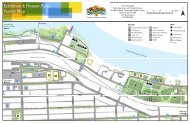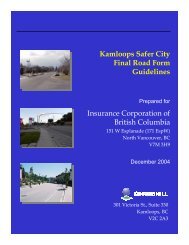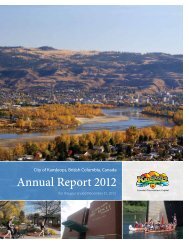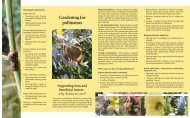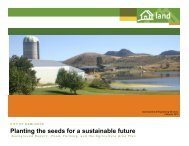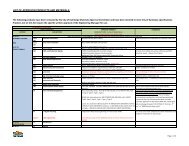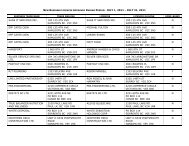GEOTOUR GUIDE - City of Kamloops
GEOTOUR GUIDE - City of Kamloops
GEOTOUR GUIDE - City of Kamloops
You also want an ePaper? Increase the reach of your titles
YUMPU automatically turns print PDFs into web optimized ePapers that Google loves.
(sTop 11) maKinG ConCreTe and asphalT:<br />
mosTly loCal earTh maTerials<br />
Figure 47. A redi-mix concrete and asphalt plant, and gravel pit along Yellowhead Highway 5 at Paul Lake Road. Sand and gravel deposits are sorted<br />
by screening into separate piles <strong>of</strong> gravel and sand, and used in the production <strong>of</strong> concrete.<br />
Figure 48. Sand, gravel, cement, additives, and water stored in the tower are<br />
carefully measured and mixed at the concrete redi-mix plant. (Photo by R.Turner)<br />
Try to imagine <strong>Kamloops</strong> without concrete. There would be no highway<br />
overpasses, home basements, building foundations, or roadside curbs.<br />
Many tall buildings in the city centre, river bridges, and important parts<br />
<strong>of</strong> Highway 1 through <strong>Kamloops</strong> would be missing. Now let’s imagine<br />
<strong>Kamloops</strong> without asphalt. There would be no sealed or paved roads,<br />
highways, or parking lots. Roads would be dusty in summer and muddy<br />
in winter.<br />
Hundreds <strong>of</strong> thousands <strong>of</strong> tons <strong>of</strong> concrete and asphalt are made and<br />
used each year in the <strong>Kamloops</strong> area. What might surprise you is that the<br />
major ingredient <strong>of</strong> our asphalt and concrete is sand and gravel from the<br />
<strong>Kamloops</strong> area.<br />
Concrete is the most widely used construction material globally. Twice as much concrete is used in construction than all other<br />
building materials combined, including wood, steel, plastic and aluminum. Concrete is made by combining water with nine parts<br />
sand and gravel and one part cement. Sand and gravel make up the bulk <strong>of</strong> concrete; cement is the glue that holds it together. To make<br />
the cement “glue”, limestone, shale, and sand are mixed and ground to a fine powder, and then roasted at high heat. Sand and gravel<br />
for <strong>Kamloops</strong>’ concrete is quarried from local gravel pits, while some cement is from local limestone, silica, and gypsum (Stop 10).<br />
Asphalt is similar to concrete in that it is made primarily <strong>of</strong> local rock materials. The Paul Lake Road plant uses crushed rock from<br />
a quarry near the <strong>Kamloops</strong> airport. However, its “glue” is liquid bitumen, a tar-like hydrocarbon related to petroleum and natural<br />
gas. The liquid asphalt is brought to <strong>Kamloops</strong> by truck or rail car from a petroleum refinery in Vancouver.<br />
Where does sand and gravel come from? The answer is ancient rivers. Extensive sand and gravel deposits occur below flat benches<br />
within the valleys <strong>of</strong> the Thompson rivers. The benches are flat because they are former river beds. Gravels also occur below gently<br />
sloping “alluvial fans” where side valleys enter the main river valleys, such as at Paul Lake Road. The sand and gravel bars <strong>of</strong> the<br />
North Thompson and Thompson rivers, visible when river levels are low, remind us that rivers form clean gravel and sand deposits<br />
by flushing the finer mud downstream to where it settles in the quiet waters <strong>of</strong> lakes or ocean.<br />
How to get to tHe ConCrete and aspHalt plant: Drive north from downtown along Highway 5<br />
and turn right on Paul Lake Road. A large sand and gravel pit and concrete and asphalt plant operation is on the north<br />
side <strong>of</strong> the road at the intersection with Chief Louis Road. Pull <strong>of</strong>f on the road shoulder and take a look. There are also<br />
several large sand and gravel pits on Barnhartvale Road east <strong>of</strong> <strong>Kamloops</strong>.<br />
27




